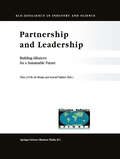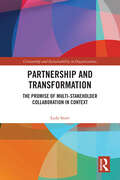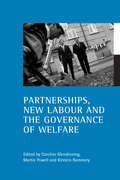- Table View
- List View
Partnership and Leadership: Building Alliances for a Sustainable Future (Eco-Efficiency in Industry and Science #8)
by ArnoldTukker Theo J. N. M.BruijnSustainable development has become a central perspective in environmental strategies around the world. It is clear that neither governments nor businesses have the capability to bring about sustainability on their own. Therefore, collaboration has emerged as a central concept. At the same time it is obvious that someone has to take the lead in the development towards sustainability. This book focuses on different forms of collaboration emerging between various actors. The objective of the book is to more systematically explore the different roles and relationships between partnership and leadership. Basically, both partnership and leadership can be seen in a positive and negative way: for example, as far as partnership is concerned, we can assume that the path towards sustainability can be paved by parties coming together, taking some initiative collaborating. On the opposite, partnership and consensus-based decisions can be seen as an obstacle to foster radical changes in production and consumption patterns. Similarly, leadership can be seen as an obstacle to sustainable development if leaders form close circles and are not willing to share experiences with other actors; but leadership could also be considered as an important element to keep concepts and practices forward. The book holds this double perspective: explaining, mapping and analyzing different goals/formats/methods of more and less collaborative approaches, but at the same time taking a critical approach to the theme by understanding related risks, effects, prospects and corrective actions. Next to a conceptual part, the book brings together case-studies from around the world. The focus is in describing and understanding various formats of collaboration and critically evaluating its effects and prospects. A concluding chapter discusses the role of partnership and leadership in realizing various levels of environmental innovations: optimization and re-design, that usually affect only a small part of the production/consumption structure, and much more complicated, radical innovations that have to deal with societal (sub)systems. The book is in part an edited version of selected papers presented during the 1998 Greening of Industry Conference in Rome on the subject, enriched with contributions of other invited authors.
Partnership and Transformation: The Promise of Multi-stakeholder Collaboration in Context (Citizenship and Sustainability in Organizations)
by Leda StottOver the last 30 years, partnership has received growing attention across a range of sectors and disciplines. Widely used to describe a relationship in which different actors pool their resources, knowledge and skills to address common problems, partnership is currently presented as central to the achievement of more inclusive and sustainable development. Rejecting "one size fits all" approaches, and mindful of different understandings of the term, Partnership and Transformation: The Promise of Multi-stakeholder Collaboration in Context, which is designed to appeal to both academics and practitioners alike, argues that partnership must be understood in relation to specific contexts and the added value it may offer for individuals, organisations and wider society. It is further suggested that the transformational potential of partnership rests critically upon a move away from purely instrumental considerations of its worth to a deeper appreciation of its intrinsic value as a process based on interpersonal relationships. A stronger balance between pragmatic and reflective dimensions of partnership can, the author claims, enhance opportunities for meaningful deliberation and productive conflict and contribute to the systems change needed for a global citizenship that embraces human well-being and stewardship of the planet.
Partnership and Transformation: The Promise of Multi-stakeholder Collaboration in Context (Citizenship and Sustainability in Organizations)
by Leda StottOver the last 30 years, partnership has received growing attention across a range of sectors and disciplines. Widely used to describe a relationship in which different actors pool their resources, knowledge and skills to address common problems, partnership is currently presented as central to the achievement of more inclusive and sustainable development. Rejecting "one size fits all" approaches, and mindful of different understandings of the term, Partnership and Transformation: The Promise of Multi-stakeholder Collaboration in Context, which is designed to appeal to both academics and practitioners alike, argues that partnership must be understood in relation to specific contexts and the added value it may offer for individuals, organisations and wider society. It is further suggested that the transformational potential of partnership rests critically upon a move away from purely instrumental considerations of its worth to a deeper appreciation of its intrinsic value as a process based on interpersonal relationships. A stronger balance between pragmatic and reflective dimensions of partnership can, the author claims, enhance opportunities for meaningful deliberation and productive conflict and contribute to the systems change needed for a global citizenship that embraces human well-being and stewardship of the planet.
Partnership, Collaborative Planning and Urban Regeneration
by John McCarthyApproaches to urban regeneration have changed dramatically throughout Europe and the USA over recent decades, drawing on notions of public-private partnership, growth coalitions and local spatial alliances. In this engaging book John McCarthy provides critical consideration of such theories in terms of their application to practice. He shows how these notions are used to explain the nature and underlying processes of urban development and to further objectives for urban regeneration. To test their applicability, he examines the case of Dundee, including the role of the Dundee Partnership, a model for many aspects of partnership working. The resulting conclusions suggest ways in which the practice of urban regeneration can be improved in terms of inclusion, equity and sustainability.
Partnership, Collaborative Planning and Urban Regeneration
by John McCarthyApproaches to urban regeneration have changed dramatically throughout Europe and the USA over recent decades, drawing on notions of public-private partnership, growth coalitions and local spatial alliances. In this engaging book John McCarthy provides critical consideration of such theories in terms of their application to practice. He shows how these notions are used to explain the nature and underlying processes of urban development and to further objectives for urban regeneration. To test their applicability, he examines the case of Dundee, including the role of the Dundee Partnership, a model for many aspects of partnership working. The resulting conclusions suggest ways in which the practice of urban regeneration can be improved in terms of inclusion, equity and sustainability.
Partnership Governance in Public Management: A Public Solutions Handbook (The Public Solutions Handbook Series)
by Marc Holzer Seth A. GrossmanThe ability to create and sustain partnerships is a skill and a strategic capacity that utilizes the strengths and offsets the weaknesses of each actor. Partnerships between the public and private sectors allow each to enjoy the benefits of the other: the public sector benefits from increased entrepreneurship and the private sector utilizes public authority and processes to achieve economic and community revitalization. Partnership Governance in Public Management describes what partnership is in the public sector, as well as how it is managed, measured, and evaluated. Both a theoretical and practical text, this book is a what, why, and how examination of a key function of public management. Examining governing capacity, community building, downtown revitalization, and partnership governance through the lens of formalized public-private partnerships – specifically, how these partnerships are understood and sustained in our society – this book is essential reading for students and practitioners with an interest in partnership governance and public administration and management more broadly. Chapters explore partnering technologies as a way to bridge sectors, to produce results and a new sense of public purpose, and to form a stable foundation for governance to flourish.
Partnership Governance in Public Management: A Public Solutions Handbook (The Public Solutions Handbook Series)
by Marc Holzer Seth A. GrossmanThe ability to create and sustain partnerships is a skill and a strategic capacity that utilizes the strengths and offsets the weaknesses of each actor. Partnerships between the public and private sectors allow each to enjoy the benefits of the other: the public sector benefits from increased entrepreneurship and the private sector utilizes public authority and processes to achieve economic and community revitalization. Partnership Governance in Public Management describes what partnership is in the public sector, as well as how it is managed, measured, and evaluated. Both a theoretical and practical text, this book is a what, why, and how examination of a key function of public management. Examining governing capacity, community building, downtown revitalization, and partnership governance through the lens of formalized public-private partnerships – specifically, how these partnerships are understood and sustained in our society – this book is essential reading for students and practitioners with an interest in partnership governance and public administration and management more broadly. Chapters explore partnering technologies as a way to bridge sectors, to produce results and a new sense of public purpose, and to form a stable foundation for governance to flourish.
Partnership working: Policy and practice
by Susan Balloch Marilyn TaylorOver the past 10 years partnership working has become a central feature of public services. This book analyses experience of partnerships in different policy fields, identifying the theoretical and practical impediments to making partnership work and critically evaluating the advantages and disadvantages for those involved. Its broad coverage goes beyond the confines of statutory partnerships, addressing other important forms of collaboration between voluntary, private and statutory sectors and service users and community and minority groups. Through a wide range of perspectives, Partnership working aims to integrate theory and practice across a number of policy areas. Using a variety of models, it: highlights both positive and negative aspects of partnership working at political, cultural and technical levels; shows how partnerships can empower people and groups through effective collaboration; suggests some of the principles on which good practice should be based and the resources required; addresses key issues of accountability, representation and social exclusion. The book provides important reading for academics, policy makers, service providers and senior practitioners in community development and community safety, local government, housing, social services and health. It will also be a valuable resource for those working in voluntary organisations and students on professional courses.
Partnership Working in Health and Social Care: What Is Integrated Care And How Can We Deliver It? (Second Edition) (PDF) (Better Partnership Working Ser.)
by Jon Glasby Helen DickinsonUK health and social care are increasingly being asked to work together across traditional agency boundaries. Although this sounds easy in theory, doing it in practice is complicated and difficult. In many cases, moreover, current training programmes, research and textbooks are even more divided than front-line services, and practitioners and managers are often being given the task of making partnerships work without the necessary support. Against this background, the second edition of this bestselling book provides a concise 'warts and all' introduction to partnership and integration, summarising updated references to current policy and research, setting out useful frameworks and approaches, and helping policy makers and practitioners to work more effectively together, with greater emphasis on ‘integrated care’. Written by the leading authors in the field and fully updated since the Health and Social Care Act 2012, the book is also fully evidence- and research-based, while still being accessible and applicable to everyday practice. Aimed at students, practitioners, managers and policy makers in health and social care, and including new reflective exercises and boxed examples, this is still the one book that everyone in the field should read.
Partnership Working in Public Health (Evidence For Public Health Practice Ser.)
by David Hunter Neil PerkinsThe UK government’s reforms of the NHS and public health system require partnerships if they are to succeed. Those partnerships concerned with public health are especially important and are deemed to be a ’good thing’ which add, rather than consume, value. Yet the significant emphasis on partnership working to secure effective policy and service delivery exists despite the evidence testifying to how difficult it is to make partnerships work or achieve results. Partnership working in public health presents the findings from a detailed study of public health partnerships in England. The lessons from the research are used to explore the government’s changes in public health now being implemented, most of which centre on new partnerships called Health and Wellbeing Boards that have been established to work differently from their predecessors.The book assesses their likely impact and the implications for the future of public health partnerships. Drawing on systems thinking, it argues that partnerships can only succeed if they work in quite different ways. The book will therefore appeal to the public health community and students of health policy.
Partnerships: Machines of possibility
by Niels Åkerstrøm AndersenEveryone is talking about partnerships: environmental partnerships, social partnerships, public-private partnerships, partnerships between NGOs in Europe and the third world. How did partnerships come to emerge almost everywhere and at almost the same time? What is the inner logic of partnerships? And at what point does that logic begin to break down? In a highly complex society, the conditions on which agreements are built are constantly changing, demanding, first and foremost, that parties agree to reach an agreement. Partnering is an answer to the growing differentiation and dynamism of the societies in which we live. While this answer holds great potential, however, it is also very fragile. It is the aim of this book to improve our understanding of the shifting ground on which agreements must be reached in today's hyper-complex society.
Partnerships and Foundations in Global Health Governance (International Political Economy Series)
by Simon Rushton and Owain David WilliamsThis book argues that the new actors in global health constitute a 'private turn' in global health governance, and provides theoretical and practical grounds for viewing global health partnerships and philanthropic foundations as closely aligned in their ideational and material approaches to a range of important issues and crises.
Partnerships and Regimes: The Politics of Urban Regeneration in the UK
by Jonathan S. DaviesThis title was first published in 2001. During the 1990s, urban regeneration partnerships proliferated in the UK. It is now commonplace for many individuals and organizations, including businesses, community groups, the voluntary sector and other public sector bodies, to co-operate with local authorities in a wide range of activities. Interest in partnerships between local government and local businesses has been given added momentum by the increasing popularity of urban regime theory as a tool for understanding urban politics in the UK. Regime theory is an American neo-pluralist account of urban politics which is concerned with local collaborative dynamics and processes, particularly those between local government and business leaders. It focuses on one facet of local governance, the relationship between the local authority and the business sector in regeneration activities.
Partnerships and Regimes: The Politics of Urban Regeneration in the UK
by Jonathan S. DaviesThis title was first published in 2001. During the 1990s, urban regeneration partnerships proliferated in the UK. It is now commonplace for many individuals and organizations, including businesses, community groups, the voluntary sector and other public sector bodies, to co-operate with local authorities in a wide range of activities. Interest in partnerships between local government and local businesses has been given added momentum by the increasing popularity of urban regime theory as a tool for understanding urban politics in the UK. Regime theory is an American neo-pluralist account of urban politics which is concerned with local collaborative dynamics and processes, particularly those between local government and business leaders. It focuses on one facet of local governance, the relationship between the local authority and the business sector in regeneration activities.
Partnerships Between Health and Local Government
by Stephanie Snape Pat TaylorThe theme of this collection of essays is partnerships between health and local government. Such partnerships are not new. Nor is discussion of the merits (or otherwise) of collaboration between the two sectors. The history of collaboration between these two sectors of the public services has been chequered to say the least; indeed, the boundary between health and social care has been described as a 'Berlin Wall'.However, New Labour's ascension to power in 1997 has rekindled an avid interest in this issue. The government's emphasis on partnerships and collaboration has been projected as a key element of its 'Third Way' philosophy. Partnership working in particular has been viewed as the most appropriate means of addressing endemic, obdurate social ills, such as social exclusion, poor health, poverty, and low educational standards.
Partnerships Between Health and Local Government
by Stephanie Snape Pat TaylorThe theme of this collection of essays is partnerships between health and local government. Such partnerships are not new. Nor is discussion of the merits (or otherwise) of collaboration between the two sectors. The history of collaboration between these two sectors of the public services has been chequered to say the least; indeed, the boundary between health and social care has been described as a 'Berlin Wall'.However, New Labour's ascension to power in 1997 has rekindled an avid interest in this issue. The government's emphasis on partnerships and collaboration has been projected as a key element of its 'Third Way' philosophy. Partnership working in particular has been viewed as the most appropriate means of addressing endemic, obdurate social ills, such as social exclusion, poor health, poverty, and low educational standards.
Partnerships for Livable Cities
by Cor Van Montfort Ank MichelsIn this volume scholars from around the world discuss the innovative forms of collaboration between public and private actors that contribute to making our cities more liveable. It offers helpful insights into the practices of partnerships and the ways in which partnerships can contribute to a more liveable urban environment. The liveability of our cities is a topic of increasing relevance and urgency. The world’s cities are becoming congested and polluted, putting pressure on affordable housing and causing safety to become a major problem. Urban governments are unable to address these major challenges on their own, and thus they seek cooperation with other governments, companies, civil society organizations, and citizens. By focusing on examples such as greenery in the city, affordable housing, safety, neighbourhood revitalization, and ‘learning by doing’ in urban living labs, this book asks two key questions. How do partnerships between public and private actors contribute to the liveability of cities? Under what conditions are partnerships successful, and when do they fail to yield the desired results?
Partnerships for Smart Growth: University-Community Collaboration for Better Public Places
by Gerrit Knaap Wim WiewelLinking the worlds of community development, higher education administration, and urban design, this accessible guidebook offers useful information on how universities and communities can best develop partnership projects. Its focus on smart growth projects further enhances its value for those interested in how urban, suburban, and rural growth can be accommodated while preserving open spaces and quality of life. Partnerships for Smart Growth includes 13 case studies for university-community collaborations on smart growth initiatives. The chapters include geographically diverse locations and urban, suburban, and rural projects. Each case includes a comprehensive discussion of how and why the project was initiated, who was involved, what techniques were employed, what were the pitfalls, and what was the outcome. The result is a book with wide appeal for university administrators, land-use planners and administrators, scholars, and community development experts.
Partnerships for Smart Growth: University-Community Collaboration for Better Public Places (Cities And Contemporary Society Ser.)
by Gerrit Knaap Wim WiewelLinking the worlds of community development, higher education administration, and urban design, this accessible guidebook offers useful information on how universities and communities can best develop partnership projects. Its focus on smart growth projects further enhances its value for those interested in how urban, suburban, and rural growth can be accommodated while preserving open spaces and quality of life. Partnerships for Smart Growth includes 13 case studies for university-community collaborations on smart growth initiatives. The chapters include geographically diverse locations and urban, suburban, and rural projects. Each case includes a comprehensive discussion of how and why the project was initiated, who was involved, what techniques were employed, what were the pitfalls, and what was the outcome. The result is a book with wide appeal for university administrators, land-use planners and administrators, scholars, and community development experts.
Partnerships for Sustainability in Contemporary Global Governance: Pathways to Effectiveness (Routledge Research in Environmental Policy and Politics)
by Liliana B. Andonova Moira V. Faul Dario PiselliPartnerships for Sustainability in Contemporary Global Governance investigates the goals, ideals, and realities of sustainability partnerships and offers a theoretical framework to help disentangle the multiple and interrelated pathways that shape their effectiveness. Partnerships are ubiquitous in research and policy discussions about sustainability and are important governance instruments for the provision of public goods. While partnerships promise a great deal, there is little clarity as to what they deliver. If partnerships are to break free from this paradox, more nuance and rigor are required for understanding and assessing their actual effects. This volume applies its original framework to diverse empirical cases in a way that could be extended to broader data sets and case studies of partnerships. The dual contribution of this volume, theoretical and empirical, holds promise for a more thorough and innovative understanding of the pathways to partnership effectiveness and the conditions that can shape their performance. The broad range of crosscutting analyses suggest important practical implications for the design of new partnerships and the updating of existing initiatives. This interdisciplinary book will be of great interest to researchers, students, and practitioners within international relations, political science, sociology, environmental studies and global studies, as well as the growing number of scholars in public policy, global health and organizational and business studies who are keen to gain a deeper understanding of the pathways and mechanisms that influence the outcomes and effectiveness of cross-sector collaboration and transnational governance more broadly.
Partnerships for Sustainability in Contemporary Global Governance: Pathways to Effectiveness (Routledge Research in Environmental Policy and Politics)
by Liliana B. Andonova, Moira V. Faul and Dario PiselliPartnerships for Sustainability in Contemporary Global Governance investigates the goals, ideals, and realities of sustainability partnerships and offers a theoretical framework to help disentangle the multiple and interrelated pathways that shape their effectiveness. Partnerships are ubiquitous in research and policy discussions about sustainability and are important governance instruments for the provision of public goods. While partnerships promise a great deal, there is little clarity as to what they deliver. If partnerships are to break free from this paradox, more nuance and rigor are required for understanding and assessing their actual effects. This volume applies its original framework to diverse empirical cases in a way that could be extended to broader data sets and case studies of partnerships. The dual contribution of this volume, theoretical and empirical, holds promise for a more thorough and innovative understanding of the pathways to partnership effectiveness and the conditions that can shape their performance. The broad range of crosscutting analyses suggest important practical implications for the design of new partnerships and the updating of existing initiatives. This interdisciplinary book will be of great interest to researchers, students, and practitioners within international relations, political science, sociology, environmental studies and global studies, as well as the growing number of scholars in public policy, global health and organizational and business studies who are keen to gain a deeper understanding of the pathways and mechanisms that influence the outcomes and effectiveness of cross-sector collaboration and transnational governance more broadly.
Partnerships in International Policy-Making: Civil Society and Public Institutions in European and Global Affairs (International Series on Public Policy)
by Raffaele MarchettiThis book analyzes how international organizations and the European Union engage with civil society to pursue their policy goals. Multi-stakeholder initiatives, private-public partnership, sub-contracting, political alliances, hybrid coalitions, multi-sectoral networks, pluralist co-governance, and indeed foreign policy by proxy are all considered. Bringing together the most advanced scholarship, the book examines trade, environment, development, security, and human rights with reference to both EU and global institutional settings such as the WTO, UN Climate Summits, FAO, IFAD, ICC, UNHRC, UNSC, and at the EU level the DG FISMA, TRADE, CLIMA, DEVCO, HOME and ECHO. The book also studies the use of NGOs in the foreign policy of the EU, USA, and Russia. This changing politics and the polarized debate it has generated are explored in detail.
Partnerships in Urban Governance: European and American Experiences
by Jon PierreThese essays explore the utility of thinking about public-private partnerships for local economic development. A theoretical examination of theories of governance, institutions and policy instruments is supplemented by empirical analysis and comparisons of their operation in the United Kingdom, Sweden and the United States in the context of debates about the 'limits of politics' and dependence on the institutions of civil society.
Partnerships, New Labour and the governance of welfare
by Caroline Glendinning Martin PowellCurrent policy encourages 'partnerships' - between statutory organisations and professionals; public and private sectors; with voluntary organisations and local communities. But is this collaborative discourse really as distinctive as the Labour Government claims? How far do contemporary partnerships exemplify an approach to governing which is based on networks (as distinct from hierarchies and markets)? Partnerships, New Labour and the governance of welfare: provides an up-to-date critical analysis of partnerships; addresses the highly topical theme of 'partnerships' as the means of achieving joined-up government; presents empirical evidence from a wide range of welfare partnerships; examines the relationships between local welfare partnerships and the management of those partnerships by central government; reveals the imbalance of power which characterises many contemporary partnerships. · It is essential reading for academics and students of contemporary social and public policy and for those with an interest in networks and other theories of welfare governance.
Partnerships, Power and Peacebuilding: NGOs as Agents of Peace in Aceh and Timor-Leste (Rethinking Peace and Conflict Studies)
by T. DibleyBy highlighting the scope and limitations of local NGO agencies, this book presents a unique perspective of the relationship between peacebuilding theory and its application in practice, outlining how well-educated, well-connected local decision makers and thinkers navigate the uneven power dynamics of the international aid system.

















